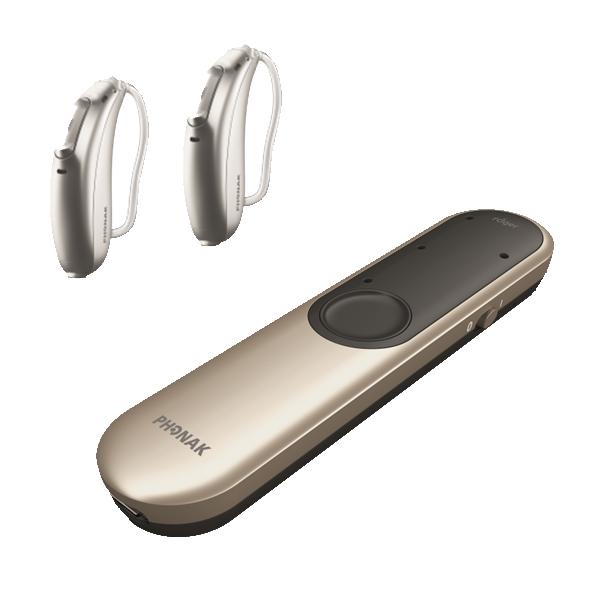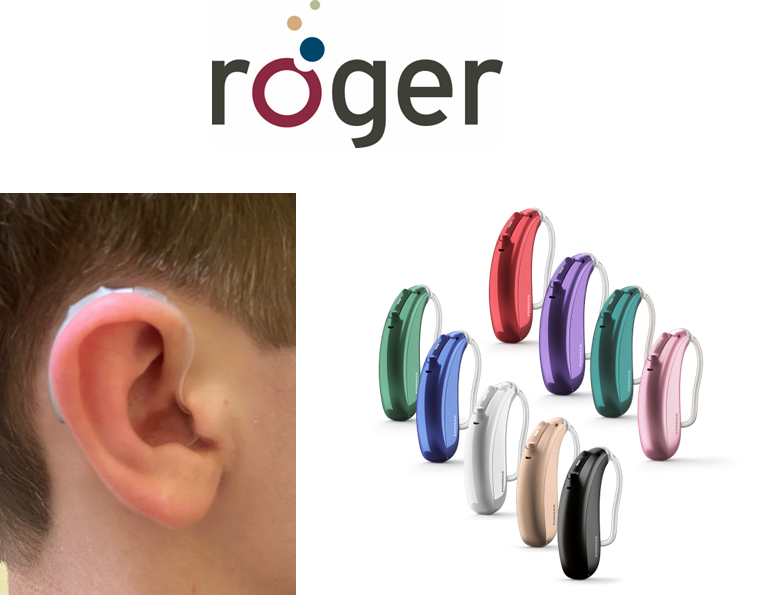Sending the teacher’s voice directly to your child’s ear can help your child focus and improve speech understanding.
A remote microphone system is assistive hearing technology designed for individuals with normal hearing. This can make a huge difference in a child’s ability to understand and focus on instruction at school. The child’s teacher wears a microphone that picks up sound close to her mouth and transmits it to tiny earpieces (ear-level receivers) worn by the student. This allows the child to hear the teacher clearly as if she was talking directly into the child’s ear. Since this brings the teacher’s voice closer, it improves the clarity of the teacher’s voice and reduces distracting background noise, helping the child pay attention and keep up with classroom instructions.
Who can benefit from remote microphones?
There is strong evidence that remote microphone systems benefit most if not all children with APD (and many with ADHD, dyslexia, autism spectrum disorder, and other disorders) as well as adults with various types of auditory processing disorder. Research also shows a double benefit – both assistive (immediately assisting hearing), and therapeutic (permanent improvement in hearing skills over time) making hearing technology a powerful treatment for APD.
Assistive Benefits
- Academic performance
- Attention and participation
- Phonological awareness, reading
- Psychosocial development, confidence, self-esteem
- Reduced classroom stress (children with ASD)
- Less tired
Digitally Modulated (DM) Systems: Superior clarity over FM systems.
The older technology was previously known as a personal FM system or assistive listening device. These systems worked similarly, but the sound quality was not as good, and there was the risk of interference from nearby FM signals. The newest, most advanced wireless microphone technology, a Roger Focus II system, uses a digitally modulated (DM) signal. This provides superior sound quality compared to older FM systems without the risk of interference. Research indicates speech in noise performance when using Roger technology was significantly better than that obtained using traditional and Dynamic FM technology, with the greatest benefits at the highest noise level.
Some schools may have FM or infrared sound field (speaker) systems to transmit the teacher’s voice to speakers around the classroom. While this may seem like a good option since all the students in the room could benefit, ear-level receivers are more effective at improving the clarity of soft sounds and provide the best signal-to-noise ratio over sound field systems. Personal (ear-level) remote microphone systems are the only evidence-based amplification treatment shown to improve hearing in classrooms for children with APD.
Roger Focus II provides immediate ease in listening
Roger Focus II remote microphone systems are the newest, most advanced remote microphone technology, making listening instantly easier. Roger differs from other remote microphones because it uses adaptive digital technology. By sensing and dynamically adjusting to changes in the surrounding noise, Roger devices enhance the signal-to-noise ratio and automatically adapt, ensuring that the user can hear well even in noisy surroundings. In addition, unlike traditional FM systems, the digitally modulated (DM) Roger system operates with adaptive frequency hopping for interference-free listening. As a result, speech intelligibility, both at a distance and in loud settings, is significantly improved.
People with auditory processing disorder (APD), who may find it difficult to distinguish and retain what they hear in background noise or to focus on one ear when necessary, will benefit most from the instant ease of listening that the Roger Focus II system offers. It can be difficult for people with APD to block out low-level background noises that most people can easily ignore, like computer humming, people coughing, papers being shuffled, and pens clicking. This is especially difficult for individuals with amblyaudia (lazy ear) since sounds that occur on the side of their overly dominant ear override information coming from the other side. Amblyaudia causes distortion, difficulty understanding in noise, and often makes it difficult for them to focus on the side of their weaker ear. This can seem like an attention deficit if they get distracted or shut down in background noise. However, this problem cannot be resolved with stimulant medication for ADHD because it is related to impaired auditory processing skills rather than an attention impairment.
Bringing the teacher’s voice closer improves clarity.
Without an ear-level remote microphone system, the sound level and clarity of the teacher’s voice drops dramatically over a short distance. In a typical classroom, only 83% of the acoustic information reaches students in the first row. Normal hearing listeners usually do not notice that the sound quality is diminished because they get enough of the signal to fill in the gaps and guess correctly. However, children with APD need the full speech signal to reach their ears so that 100% of the signal is available for the potential to be processed and understood.
Research indicates long term therapeutic benefit.
Research with auditory cortical potentials (brain wave responses to sound) has proven that since ear-level remote microphone systems improve the clarity of soft sounds (such as f, t, p, k, th, h and blends) they improve the consistency of neural responses to sound (i.e. a “b” sounds consistently like a “b” instead of sometimes sounding more like a “d”). This actually improves the brain’s listening skills, and the effects remain even when the system is not worn anymore.
Long term therapeutic benefits (measured without the remote microphone systems on) after up to 12 months of use include improvements in:
- Consistency of auditory brainstem responses to speech stimuli
- Amplitude and latencies of cortical auditory evoked potentials
- Binaural temporal resolution
- Frequency discrimination
- Frequency pattern recognition
- Auditory working memory
- Language
- Speech perception in quiet conditions
- Spatial stream segregation (speech perception in noise)
- Self-perceived listening ability
- Parent and teacher ratings of hearing ability
(Hornickel et al., 2012; Friederichs & Friederichs, 2005; Smart, Purdy, & Kelly, 2010; Smart, Purdy, & Kelly, 2018; Umat et al., 2011; Yip & Rickard, 2011; Sharma et al., 2012; Johnson et al., 2009).
In addition to children with APD, children with Dyslexia, ADHD, and Autism Spectrum Disorder also benefit significantly from remote microphone/FM systems. Since this assistive hearing technology provides the brain with a clearer auditory signal, it improves the child’s ability to process speech in background noise and focus on instruction.
Facilitates progress in reading in children with dyslexia
Since many children with dyslexia have problems distinguishing similar sounds, the improved clarity from bringing the talker’s voice directly to the child’s ears helps the child hear each sound distinctly. This helps the brain learn to map sounds correctly onto phonograms (written symbols), which can facilitate a child’s progress in dyslexia therapy.
Research shows that children with dyslexia had more consistent auditory brainstem responses to speech after using a remote microphone system for one school year. In addition, the more precise sound quality helped facilitate the child’s awareness of the distinctive features of speech sounds, contributing to improved phonological awareness and reading. The Auditory Neuroscience Laboratory at Northwestern University has many research articles and an excellent slideshow demonstrating the therapeutic benefits of remote microphone systems in improving the neural processing of speech, leading to improved reading.
Instantly improves focus for children with ADHD
Numerous studies have proven that remote microphone systems can help children with ADHD overcome some of their listening and attending problems in a classroom environment. Participants with ADHD medicated and ADHD non-medicated both experienced increases in academic scores. Reading, spelling, math, and social studies scores improved significantly by the end of the academic year.
Aids social interaction and improves educational outcomes in children with autism spectrum disorder.
Studies show that using remote microphone systems improves listening, on-task behavior, and tolerance of noise in the classroom, at home, and in social situations for children with autism spectrum disorder (ASD). Research also shows enhanced speech understanding in noise and improved auditory working memory and comprehension scores.
Adults with APD can also benefit from remote microphone systems
Remote microphone systems are also beneficial for adults with normal hearing sensitivity that have problems hearing in background noise and difficulty participating in group conversations and meetings. The Roger Select microphone and the newest model, the Roger On microphone, both offer flexibility to be either worn by the primary talker/presenter, or placed on a table to work as a conference microphone and enable the listener to hear the people sitting around it. The Roger On microphone can also be pointed in the direction of a person speaking to zoom in on a talker or conversation they want to hear better. When placed on a table, the fully automatic directional microphones are able to distinguish the directions of incoming speech, discreetly and automatically select the person who is talking, and seamlessly switch from one talker to another. When multiple conversations occur at the same time, the listener can manually select whom to listen to. Through the myRogerMic app the listener can discreetly steer the direction of the microphone beam to focus on one or several specific talkers. This allows the listener to fully engage in the conversation when background noise is present and reduces fatigue and frustration from trying to keep up with ongoing speech. Roger microphone transmitters can also easily be connected to a TV, video conference, and other mulitmedia sources to transmit the sound of these devices. Additional benefits include using Roger technology during sports activities and group exercise classes. The Roger remote microphones bridge the distance to help the listener hear instructions from a coach clearly, conquering challenges from distance, other people talking, or music in the background. Listeners can also benefit from Roger technology in the car to help overcome the communication challenges while on the road.
For more information, download our brochure on Roger Focus for Auditory Processing Disorder, our brochure on the benefits of Roger Focus for individuals with Autism Spectrum Disorder, and our flyer on Remote Microphone Systems for ADHD.
If you are interested in ordering a system, contact Auditory Processing Center so that we can discuss your child and determine if he/she is a good candidate.
A typical remote microphone system comes with two Roger Focus Receivers (earpieces) and one teacher/parent microphone. If the child changes classes, he/she passes the microphone to the next teacher. If there are multiple children with Roger Focus receivers in the same classroom, the teacher only needs to wear one microphone. A simple push of a button on the microphone while placed next to each earpiece, will sync it to multiple receivers.
Auditory Processing Center offers a free in-office demonstration so that you can see the benefits first hand. We also have remote microphone systems that can be checked out for a one-week trial.
Additional Information
- Assistive listening devices drive neuroplasticity in children with dyslexia
- Critical review of remote microphone technology
- FM for children with dyslexia
- Field Study – Roger Focus for auditory processing disorder
- For reading development auditory processing is fundamental
- Transforming education for children with autism spectrum disorder
- Effects of auditory training and remote microphone technology on the behavioral performance of children and young adults who have autism spectrum disorder
- The use of FM systems for children with attention defi cit dsorder
- The use of listening devices to ameliorate auditory deficit in children with autism
- Personal FM systems for children with autism spectrum disorders (ASD) and/or attention-deficit hyperactivity disorder (ADHD): an initial investigation
- Assistive technology evaluations: Remote-microphone technology for children with Autism Spectrum Disorder





